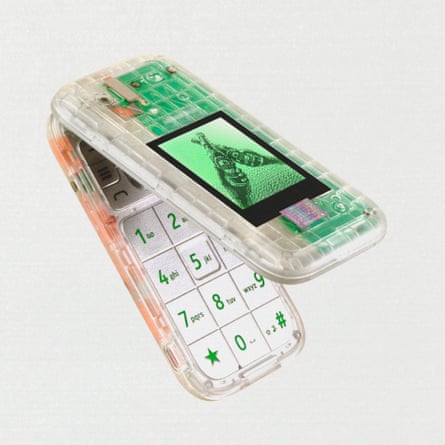It’s almost enough to make you stop doomscrolling: dull devices are now cool.
The Boring Phone is a new, featureless flip phone that is feeding the growing appetites of younger people who want to bin their smartphones in favour of a dumbphone.
The latest model is a collaboration between Heineken beer and the fashion retailer Bodega, and caused a storm when it was unveiled this month at Milan design week, the place where trends are anointed by the world’s designers. The Boring Phone is part of a new dumbphone boom, built on the suspicion of gen Z towards the data- and attention-harvesting technologies they have grown up with. That suspicion has fuelled reinventions of retro cultural artefacts – a trend known as Newtro – and seen in the revival of vinyl records, cassettes, fanzines, 8-bit video games and old-fashioned mobile phones.
“I’ve always hated being available to everyone,” said Rana Ali. The 29-year-old former finance worker, who is now a music producer and rapper recording as Surya Sen, added: “The idea that if you send a WhatsApp to someone and they don’t respond immediately then something’s wrong. I’ve had periods of having a smartphone but I always revert back to having a burner phone.”
Nostalgia for the Nokia 3310, the “brick” phone with seemingly everlasting battery life, prompted its relaunch in 2017, but the boom really began in the US last year and was, ironically, fuelled by TikTokers posting under the #bringbackflipphones hashtag. HMD, which was behind the Nokia relaunch, saw its flip phone sales double by April 2023, while Punkt, which prefers to call them feature phones or minimalist phones, has also seen substantial sales increases.

But Apple and Samsung are not under threat yet, according to Mintel. Nine out of 10 phones are smartphones and dumbphones remain niche, said Joe Birch, a technology analyst at the research firm.
“However, there is evidence of this generation modifying their smartphone behaviour, with concerns around the negative impacts of being constantly digitally connected driving this,” Birch added. “Three in five gen-Zers say they’d like to be less connected to the digital world, for instance.”
This move to offlining, or digital minimalism, is also seen in gen Z’s declining use of social media. They are the only generation whose time on social media has fallen since 2021, according to GWI, another research company, although older people are digitally detoxing too – including Lars Silberbauer, HMD’s chief marketing officer. “For the first four hours, you’re getting a bit of anxiety,” he said. “But then suddenly you start focusing and you get back to behaviours you used to have.”
Twentysomethings are also more concerned about privacy, according to the technology analyst Portulans Institute, in an internet that can seem more like a surveillance tool for brands, governments and scammers than a place to pursue interests and find interesting people.
Older technologies can create more freedom: sampling in hip-hop and dance music has become almost impossible for emerging artists, since Spotify or YouTube’s algorithms will spot uncleared samples and prevent tracks from uploading. But an underground artist can press 500 vinyl EPs and sell them to DJs and fans without difficulty.
The problem with offlining is that the world is increasingly difficult for people without a smartphone. There are 2.4m households in the UK that cannot afford a mobile phone contract and 2 million young people who have no access to a learning device, said Hannah Whelan, coordinator of the Data Poverty Lab at the Good Things Foundation charity. “Most essential services are now online – education, healthcare, universal credit,” she said. People who cannot scan a QR code to fill in a form or order food are at least at a disadvantage, and some systems require them.
after newsletter promotion
The Luddite Club, a group of New York schoolchildren who announced in December 2022 they were giving up their iPhones in favour of flip phones, would still need their smartphones, said Petter Neby, the founder of Punkt. “It’s impossible,” he said. “In UK schools you’re talking about banning the smartphone but you have a school system that relies on online activity, for scheduling, for homework. I would love to ban smartphones for my children, but it’s a much deeper question. We need to have a balance.”
Piers Garrett, a 27-year-old tech sales executive, tried to achieve that balance by getting a Light Phone – a device that uses the same electronic ink used for e-readers and has no apps – but eventually gave up.
“The idea was amazing, but I only lasted six months,” he said. “Everyone communicates via WhatsApp. So now I have a happy medium. I’m very strict with my apps – just banking apps and train apps, and I turn off all my notifications. Now when I wake up in the morning, I do things for myself – have a coffee, read a book. And I noticed the change – so much more clarity in my mind.”
